Introduction
Stir-frying, a cornerstone of Asian cuisine, transforms simple ingredients into vibrant, flavorful dishes. Among the many vegetables that shine in this cooking method, fresh tea tree mushrooms (Agrocybe aegerita) hold a special place. Revered for their earthy aroma, meaty texture, and ability to absorb flavors, these mushrooms are a staple in kitchens across China, Japan, and Southeast Asia. This article explores the nuances of stir-frying fresh tea tree mushrooms, from selecting the finest specimens to mastering the balance of heat, seasonings, and technique. Whether you’re a seasoned home cook or a curious novice, this guide will equip you with the knowledge to create a dish that celebrates the mushroom’s natural umami while delivering a satisfying culinary experience.
The Culinary Significance of Tea Tree Mushrooms
Tea tree mushrooms, also known as agrocybe cylindracea or naasutake in Japanese, grow naturally in tropical and subtropical regions, often clustering around the roots of tea plants. Their name reflects this symbiotic relationship, though they are now cultivated globally. Unlike delicate button mushrooms or porous shiitakes, tea tree mushrooms boast a firm, slightly crunchy texture that holds up well under high heat. Their flavor profile is uniquely savory, with hints of nuts and wood, making them a versatile ingredient in stir-fries, soups, and even grilled dishes.
In Chinese cuisine, these mushrooms are prized for their qi (energy-boosting) properties and are often used in traditional medicinal recipes. Modern chefs, however, appreciate their culinary adaptability. When stir-fried, they develop a caramelized exterior while retaining a tender interior, creating a textural contrast that elevates any meal.
Selecting the Freshest Tea Tree Mushrooms
The foundation of a great stir-fry lies in the quality of ingredients. When purchasing fresh tea tree mushrooms, look for specimens with the following traits:
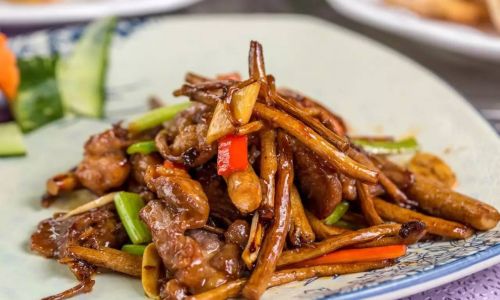
- Appearance: The caps should be firm, smooth, and uniformly brown or beige. Avoid mushrooms with wrinkled caps, as this indicates age or improper storage.
- Stem Firmness: The stems should be crisp and white, without signs of discoloration or softness. A slimy texture is a red flag for spoilage.
- Aroma: Fresh mushrooms emit a mild, earthy scent. Overpowering or sour odors suggest decay.
- Size: Smaller mushrooms (3–5 cm in diameter) tend to be more tender, while larger ones may have a tougher texture.
If fresh mushrooms are unavailable, dried varieties can be rehydrated. However, they lack the same crispness and require longer cooking times.
Essential Ingredients and Tools
To achieve wok hei—the coveted smoky flavor of stir-fries—you’ll need the right equipment and ingredients:
- Wok or Skillet: A carbon-steel wok is ideal for even heat distribution, but a large cast-iron skillet works as a substitute.
- High-Smoke-Point Oil: Peanut, grapeseed, or avocado oil withstands high temperatures without burning.
- Aromatics: Garlic, ginger, and shallots form the flavor base.
- Seasonings: Soy sauce, oyster sauce, Shaoxing wine, and a pinch of sugar balance the dish.
- Proteins (Optional): Tofu, chicken, or shrimp complement the mushrooms’ earthiness.
- Vegetables: Bell peppers, carrots, or snow peas add color and crunch.
Step-by-Step Guide to Stir-Frying
Preparation
- Clean the Mushrooms: Gently brush off dirt with a damp cloth. Avoid soaking, as mushrooms absorb water like sponges, leading to a soggy texture.
- Slice Uniformly: Trim the stems and cut larger mushrooms into bite-sized pieces for even cooking.
- Prep Aromatics: Mince garlic and ginger; slice shallots into thin rings.
- Marinate Proteins (If Using): Toss meat or tofu in a mixture of soy sauce, cornstarch, and oil to lock in moisture.
Wok Preparation
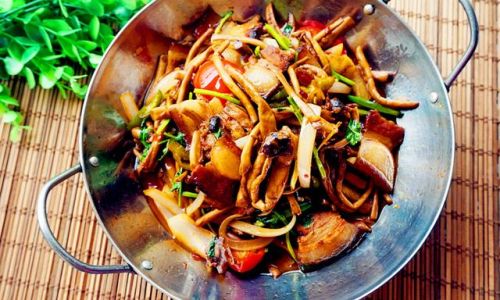
- Heat the Wok: Place it over high heat until a drop of water evaporates instantly.
- Add Oil: Swirl 1–2 tablespoons of oil to coat the surface.
Cooking the Aromatics
- Sizzle Garlic and Ginger: Add them to the hot oil and stir-fry for 10–15 seconds until fragrant.
- Avoid Burning: Remove the wok from heat if the aromatics begin to brown too quickly.
Stir-Frying the Mushrooms
- Add Mushrooms: Toss them into the wok and spread them in a single layer. Let them sear undisturbed for 30 seconds to develop caramelization.
- Stir-Fry Vigorously: Use a spatula to toss the mushrooms continuously for 2–3 minutes. High heat ensures they cook through without releasing excess moisture.
Incorporating Flavors
- Deglaze with Shaoxing Wine: Pour a splash of wine into the wok’s edges to lift any browned bits.
- Season: Drizzle soy sauce and oyster sauce, then sprinkle sugar to balance the saltiness.
- Add Vegetables/Proteins: Toss in pre-cooked proteins or quick-cooking vegetables. Stir-fry for another 1–2 minutes.
Finishing Touches
- Thicken the Sauce: If desired, stir a cornstarch slurry into the wok until the sauce clings to the ingredients.
- Garnish: A drizzle of sesame oil, a sprinkle of chopped cilantro, or a handful of toasted cashews adds complexity.
Enhancing Flavors with Aromatics and Seasonings
The beauty of stir-frying lies in its adaptability. Experiment with these variations:
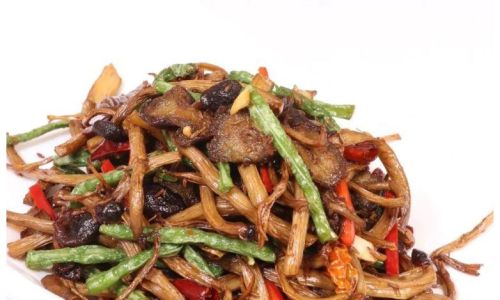
- Spicy Kick: Add fresh chili peppers or a dash of chili oil.
- Umami Bomb: Incorporate dried shrimp or fermented black beans.
- Herbal Notes: Toss in Thai basil or cilantro just before serving.
- Vegan Twist: Use mushroom-based oyster sauce and tamari for a plant-based dish.
Pairing Suggestions and Serving Ideas
Stir-fried tea tree mushrooms shine as:
- A Standalone Dish: Serve over steamed jasmine rice or alongside egg noodles.
- Part of a Multi-Course Meal: Pair with lighter dishes like steamed fish or braised greens.
- Stuffing for Dumplings: Mix cooled mushrooms with minced pork and wrap in dough.
- Pizza Topping: Roast the mushrooms first, then scatter over a crust with caramelized onions and cheese.
Health Benefits and Nutritional Profile
Tea tree mushrooms are a nutritional powerhouse. A 100-gram serving offers:
- Protein: 3 grams (ideal for plant-based diets).
- Fiber: 6 grams, aiding digestion and promoting satiety.
- Vitamins: B-complex vitamins (B2, B3) for energy metabolism.
- Minerals: Iron, potassium, and selenium, which support immune function.
Their low calorie and fat content make them a guilt-free indulgence. Additionally, beta-glucans—compounds found in mushrooms—may enhance immune response and reduce inflammation.
Exploring Regional Variations
Tea tree mushrooms transcend borders, inspiring diverse preparations:
- Chinese-Style: Combine with wood ear mushrooms and bamboo shoots in a savory sauce.
- Thai-Inspired: Add fish sauce, lime leaves, and holy basil for a tangy-sweet profile.
- Japanese Tempura: Lightly batter and deep-fry for a crispy appetizer.
- Korean Banchan: Toss with gochujang, sesame seeds, and scallions for a spicy side dish.
Tips for Perfect Stir-Fries Every Time
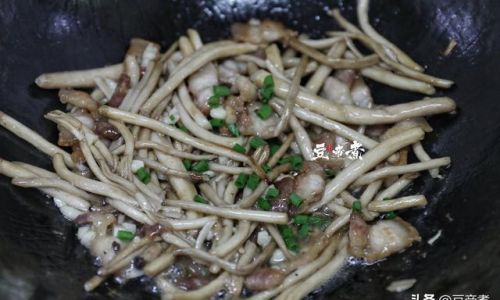
- Prep Ahead: Chop all ingredients before igniting the stove. Stir-frying moves quickly, leaving no room for hesitation.
- Master Heat Control: High heat sears ingredients, while medium heat gently cooks through thicker items.
- Avoid Overcrowding: Cook in batches if necessary to prevent steaming, which results in soggy mushrooms.
- Taste and Adjust: Season incrementally, as flavors intensify during cooking.
- Embrace Wok Hei: The slight char from high heat adds depth—don’t fear a little smokiness!
Conclusion
Stir-frying fresh tea tree mushrooms is a dance of precision and creativity. By honoring the ingredient’s natural qualities and balancing heat, seasonings, and technique, you can craft a dish that delights the senses and nourishes the body. Whether you adhere to tradition or experiment with global flavors, these mushrooms offer a canvas for culinary expression. So, fire up your wok, gather your ingredients, and embark on a journey that transforms humble fungi into a feast for the ages.

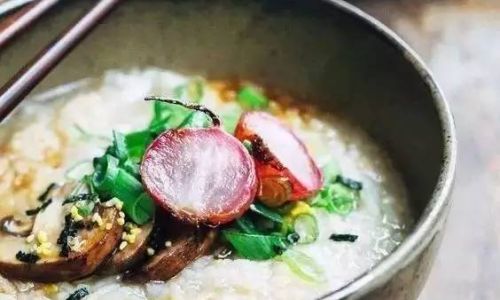



0 comments